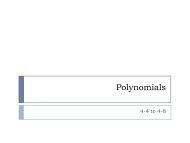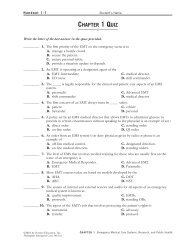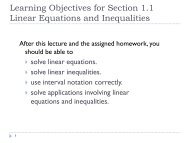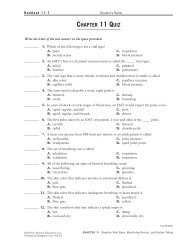Learning Objectives for Section 7.4 Permutations and Combinations ...
Learning Objectives for Section 7.4 Permutations and Combinations ...
Learning Objectives for Section 7.4 Permutations and Combinations ...
Create successful ePaper yourself
Turn your PDF publications into a flip-book with our unique Google optimized e-Paper software.
5/4/2011<br />
<strong>Learning</strong> <strong>Objectives</strong> <strong>for</strong> <strong>Section</strong> <strong>7.4</strong><br />
<strong>Permutations</strong> <strong>and</strong> <strong>Combinations</strong><br />
The student will be able to set up <strong>and</strong> compute factorials.<br />
The student will be able to apply <strong>and</strong> calculate permutations.<br />
The student will be able to apply <strong>and</strong> calculate combinations.<br />
The student will be able to solve applications involving<br />
permutations <strong>and</strong> combinations.<br />
1<br />
<strong>7.4</strong> <strong>Permutations</strong> <strong>and</strong> <strong>Combinations</strong><br />
For more complicated problems, we will<br />
need to develop two important concepts:<br />
permutations <strong>and</strong> combinations. Both<br />
of these concepts involve what is called<br />
the factorial of a number.<br />
2<br />
1
5/4/2011<br />
Definition of n Factorial (n !)<br />
n! = n(n-1)(n-2)(n-3)…1<br />
For example, 5! = 5(4)(3)(2)(1) = 120<br />
n! = n(n - 1)!<br />
0! = 1 by definition.<br />
Most calculators have an n! key or the equivalent.<br />
n! grows very rapidly, which may result in overload on a<br />
calculator.<br />
3<br />
Example<br />
The simplest protein molecule in biology is<br />
called vasopressin <strong>and</strong> is composed of<br />
8 amino acids that are chemically bound<br />
together in a particular order. The order in<br />
which these amino acids occur is of vital<br />
importance to the proper functioning of<br />
vasopressin. If these 8 amino acids were<br />
placed in a hat <strong>and</strong> drawn out r<strong>and</strong>omly one<br />
by one, how many different arrangements of<br />
these 8 amino acids are possible<br />
4<br />
2
5/4/2011<br />
Solution<br />
Solution: Let A, B, C, D, E, F, G, H symbolize<br />
the 8 amino acids. They must fill 8 slots:<br />
___ ___ ___ ___ ___ ___ ___ ___<br />
There are 8 choices <strong>for</strong> the first position,<br />
leaving 7 choices <strong>for</strong> the second slot, 6 choices<br />
<strong>for</strong> the third slot <strong>and</strong> so on. The number of<br />
different orderings is<br />
8(7)(6)(5)(4)(3)(2)(1) = 8! = 40,320.<br />
5<br />
Two Problems Illustrating<br />
<strong>Combinations</strong> <strong>and</strong> <strong>Permutations</strong><br />
Problem 1: Consider the set {p, e, n}. How many two-letter<br />
“words” (including nonsense words) can be <strong>for</strong>med from the<br />
members of this set, if two different letters have to be used<br />
6<br />
3
5/4/2011<br />
Two Problems Illustrating<br />
<strong>Combinations</strong> <strong>and</strong> <strong>Permutations</strong><br />
Problem 1: Consider the set {p, e, n}. How many two-letter<br />
“words” (including nonsense words) can be <strong>for</strong>med from the<br />
members of this set, if two different letters have to be used<br />
Solution: We will list all possibilities: pe, pn, en, ep, np, ne, a<br />
total of 6.<br />
Problem 2: Now consider the set consisting of three males:<br />
{Paul, Ed, Nick}. For simplicity, denote the set by {p, e, n}.<br />
How many two-man crews can be selected from this set<br />
7<br />
Two Problems Illustrating<br />
<strong>Combinations</strong> <strong>and</strong> <strong>Permutations</strong><br />
Problem 1: Consider the set {p, e, n}. How many two-letter<br />
“words” (including nonsense words) can be <strong>for</strong>med from the<br />
members of this set, if two different letters have to be used<br />
Solution: We will list all possibilities: pe, pn, en, ep, np, ne, a<br />
total of 6.<br />
Problem 2: Now consider the set consisting of three males:<br />
{Paul, Ed, Nick}. For simplicity, denote the set by {p, e, n}.<br />
How many two-man crews can be selected from this set<br />
Solution: pe (Paul, Ed), pn (Paul, Nick) <strong>and</strong> en (Ed, Nick),<br />
<strong>and</strong> that is all!<br />
8<br />
4
5/4/2011<br />
Difference Between<br />
<strong>Permutations</strong> <strong>and</strong> <strong>Combinations</strong><br />
Both problems involved counting the numbers of<br />
arrangements of the same set {p, e, n}, taken 2 elements at a<br />
time, without allowing repetition. However, in the first<br />
problem, the order of the arrangements mattered since pe<br />
<strong>and</strong> ep are two different “words”. In the second problem, the<br />
order did not matter since pe <strong>and</strong> ep represented the same<br />
two-man crew. We counted this only once.<br />
The first example was concerned with counting the number of<br />
permutations of 3 objects taken 2 at a time.<br />
The second example was concerned with the number of<br />
combinations of 3 objects taken 2 at a time.<br />
9<br />
<strong>Permutations</strong><br />
The notation P(n,r) represents the number of permutations<br />
(arrangements) of n objects taken r at a time, where r is less<br />
than or equal to n. In a permutation, the order is<br />
important.<br />
P(n,r) may also be written P n,r<br />
In our example with the number of two letter words from<br />
{p, e, n}, the answer is P(3,2), which represents the number<br />
of permutations of 3 objects taken 2 at a time.<br />
P(3,2) = 6 = (3)(2)<br />
In general,<br />
P(n,r) = n(n-1)(n-2)(n-3)…(n-r+1)<br />
10<br />
5
5/4/2011<br />
More Examples<br />
Find P(5,3)<br />
11<br />
More Examples<br />
Find P(5,3)<br />
Here n = 5 <strong>and</strong> r = 3, so we have<br />
P(5,3) = (5)(5-1)(5-2) = 5(4)3 = 60.<br />
This means there are 60 permutations of 5 items taken 3 at a<br />
time.<br />
Application: A park bench can seat 3 people. How many<br />
seating arrangements are possible if 3 people out of a group of 5<br />
sit down<br />
12<br />
6
5/4/2011<br />
More Examples<br />
(continued)<br />
Solution: Think of the bench as three slots ___ ___ ___ .<br />
There are 5 people that can sit in the first slot, leaving 4<br />
remaining people to sit in the second position <strong>and</strong> finally 3<br />
people eligible <strong>for</strong> the third slot.<br />
Thus, there are 5(4)(3) = 60 ways the people can sit.<br />
The answer could have been found using the permutations<br />
<strong>for</strong>mula P(5,3) = 60, since we are finding the number of ways<br />
of arranging 5 objects taken 3 at a time.<br />
13<br />
P (n,n)= n (n -1)(n -2)…1 = n !<br />
Find P(5,5), the number of arrangements of 5 objects taken 5<br />
at a time.<br />
14<br />
7
5/4/2011<br />
P (n,n)= n (n -1)(n -2)…1 = n !<br />
Find P(5,5), the number of arrangements of 5 objects taken 5<br />
at a time.<br />
Answer: P(5,5) = 5(4)(3)(2)(1) = 120.<br />
Application: A bookshelf has space <strong>for</strong> exactly 5 books. How<br />
many different ways can 5 books be arranged on this<br />
bookshelf<br />
15<br />
P (n,n)= n (n -1)(n -2)…1 = n !<br />
Find P(5,5), the number of arrangements of 5 objects taken 5<br />
at a time.<br />
Answer: P(5,5) = 5(4)(3)(2)(1) = 120.<br />
Application: A bookshelf has space <strong>for</strong> exactly 5 books. How<br />
many different ways can 5 books be arranged on this<br />
bookshelf<br />
Answer: Think of 5 slots, again.<br />
There are five choices <strong>for</strong> the first slot,<br />
4 <strong>for</strong> the second <strong>and</strong> so on until there is<br />
only 1 choice <strong>for</strong> the final slot.<br />
The answer is 5(4)(3)(2)(1),<br />
which is the same as P(5,5) = 120.<br />
16<br />
8
5/4/2011<br />
<strong>Combinations</strong><br />
In the second problem, the number of two man crews that<br />
can be selected from {p, e, n} was found to be 6. This<br />
corresponds to the number of combinations of 3 objects<br />
taken 2 at a time or C(3,2). We will use a variation of the<br />
<strong>for</strong>mula <strong>for</strong> permutations to derive a <strong>for</strong>mula <strong>for</strong><br />
combinations.<br />
Note: C(n,r) may also be written C n,r or ( n r).<br />
17<br />
<strong>Combinations</strong><br />
Consider the six permutations of {p, e, n} which are grouped<br />
in three pairs of 2. Each pair corresponds to one combination<br />
of 2:<br />
(pe, ep), (pn, np), (en, ne)<br />
If we want to find the number of combinations of 3 objects<br />
taken 2 at a time, we simply divide the number of<br />
permutations of 3 objects taken 2 at a time by 2 (or 2!)<br />
We have the following result:<br />
P(3,2)<br />
C(3,2) =<br />
2!<br />
18<br />
9
5/4/2011<br />
Generalization<br />
General result: This <strong>for</strong>mula gives the number of subsets of<br />
size r that can be taken from a set of n objects. The order of<br />
the items in each subset does not matter. The number of<br />
combinations of n distinct objects taken r at a time without<br />
repetition is given by<br />
P( n, r) n( n −1)( n − 2)...( n − r + 1)<br />
C( n, r)<br />
= =<br />
r! r( r −1)( r − 2)...1<br />
19<br />
Examples<br />
1. Find C(8,5)<br />
2. Find C(8,8)<br />
20<br />
10
5/4/2011<br />
Examples<br />
Solution<br />
1. Find C(8,5)<br />
Solution: C(8,5) =<br />
P(8,5) 8(7)(6)(5)(4) 8(7)(6)<br />
= = = 8(7) = 56<br />
5! 5(4)(3)(2)(1) 3(2)(1)<br />
2. Find C(8,8)<br />
Solution: C(8,8) =<br />
P(8,8) 8(7)(6)(5)(4)(3)(2)(1)<br />
= = 1<br />
8! 8(7)(6)(5)(4)(3)(2)(1)<br />
21<br />
<strong>Combinations</strong> or <strong>Permutations</strong><br />
In how many ways can you choose 5 out of 10<br />
friends to invite to a dinner party<br />
22<br />
11
5/4/2011<br />
<strong>Combinations</strong> or <strong>Permutations</strong><br />
(continued)<br />
In how many ways can you choose 5 out of 10<br />
friends to invite to a dinner party<br />
Solution: Does the order of selection matter<br />
If you choose friends in the order A,B,C,D,E or A,C,B,D,E, the<br />
same set of 5 was chosen, so we conclude that the order of<br />
selection does not matter. We will use the <strong>for</strong>mula <strong>for</strong><br />
combinations since we are concerned with how many subsets<br />
of size 5 we can select from a set of 10.<br />
C(10,5) =<br />
P(10,5) 10(9)(8)(7)(6) 10(9)(8)(7)<br />
= = = 2(9)(2)(7) = 252<br />
5! 5(4)(3)(2)(1) (5)(4)<br />
23<br />
<strong>Permutations</strong> or <strong>Combinations</strong><br />
(continued)<br />
How many ways can you arrange 10 books on a bookshelf<br />
that has space <strong>for</strong> only 5 books<br />
24<br />
12
5/4/2011<br />
<strong>Permutations</strong> or <strong>Combinations</strong><br />
(continued)<br />
How many ways can you arrange 10 books on a bookshelf<br />
that has space <strong>for</strong> only 5 books<br />
Solution: Does order matter The answer is yes since the<br />
arrangement ABCDE is a different arrangement of books than<br />
BACDE. We will use the <strong>for</strong>mula <strong>for</strong> permutations. We need<br />
to determine the number of arrangements of 10 objects taken 5<br />
at a time so we have<br />
P(10,5) = 10(9)(8)(7)(6)=30,240.<br />
25<br />
Lottery Problem<br />
A certain state lottery consists of selecting<br />
a set of 6 numbers r<strong>and</strong>omly from a set of<br />
49 numbers. To win the lottery, you must<br />
select the correct set of six numbers. How<br />
many possible lottery tickets are there<br />
26<br />
13
5/4/2011<br />
Lottery Problem<br />
A certain state lottery consists of selecting<br />
a set of 6 numbers r<strong>and</strong>omly from a set of<br />
49 numbers. To win the lottery, you must<br />
select the correct set of six numbers. How<br />
many possible lottery tickets are there<br />
Solution: The order of the numbers is not important here as<br />
long as you have the correct set of six numbers. To determine<br />
the total number of lottery tickets, we will use the <strong>for</strong>mula <strong>for</strong><br />
combinations <strong>and</strong> find C(49,6), the number of combinations of<br />
49 items taken 6 at a time. Using our calculator, we find that<br />
C(49,6) = 13,983,816.<br />
27<br />
14















